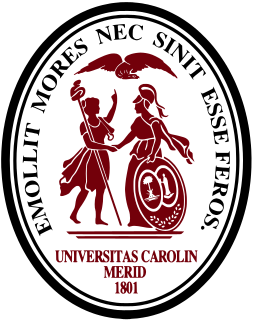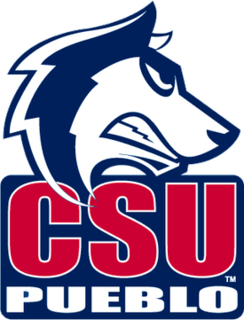
The California State University is a public university system in California. With 23 campuses and eight off-campus centers enrolling 485,550 students with 55,909 faculty and staff, CSU is the largest four-year public university system in the United States. It is one of three public higher education systems in the state, with the other two being the University of California system and the California Community Colleges. The CSU System is incorporated as The Trustees of the California State University. The California State University system headquarters are in Long Beach, California.

The University of South Carolina Aiken is a public university in Aiken, South Carolina. It is part of the University of South Carolina System and offers undergraduate degree programs as well as master's degrees. Additional graduate courses and degree programs are offered through the University of South Carolina Extended Graduate Campus program. The University of South Carolina Aiken awards baccalaureate degrees in more than 30 major areas of study include the bachelor of science in business administration online through Palmetto College.

Colorado State University is a public land-grant research university in Fort Collins, Colorado. It is the flagship university of the Colorado State University System. Colorado State University is classified among "R1: Doctoral Universities – Very high research activity".

Sacramento State University is a public university in Sacramento, California. Founded in 1947 as Sacramento State College, it is the eleventh oldest school in the 23-campus California State University system. The university enrolls approximately 31,500 students annually, has an alumni base of more than 250,000 and awards 9,000 degrees annually. The university offers 151 different Bachelor's degrees, 69 Master's degrees, 28 types of teaching credentials, and 5 Doctoral degrees.

California State University, Bakersfield is a public university in Bakersfield, California. It was established in 1965 as Kern State College and officially in 1968 as California State College Bakersfield on a 375-acre (152 ha) campus, becoming the 20th school in the 23-campus California State University system. First classes were held October 1, 1970. The university offers 45 different Bachelor's degrees and 21 types of Master's degrees. The university offers a Doctoral Program in Educational Leadership (Ed.D.).

California State University, Dominguez Hills is a public university in Carson, California. It was founded in 1960 and is part of the California State University (CSU) system.

The Cagayan State University is the largest state institution of higher learning in the Cagayan Valley Region, in terms of enrollment and number of curricular program offerings. The University was established through Presidential Decree 1436, later amended by Republic Act 8292 by the integration of all publicly supported higher education institutions in the province of Cagayan.

The Colorado Community College System is a public community college system in U.S. state of Colorado. Created by legislation in 1967, it has 13 member institutions and serves more than 163,000 students annually. Its dual oversight of community colleges and vocational education for the State of Colorado is unique in the nation.

West Kentucky Community and Technical College (WKCTC) is a public community college in Paducah, Kentucky. It is part of the Kentucky Community and Technical College System (KCTCS) and was formed by the 2003 consolidation of Paducah Community College and West Kentucky Technical College. WKCTC is accredited by the Southern Association of Colleges and Schools, Commission on Colleges (SACSCOC).

A Hispanic-serving institution (HSI) is defined in federal law as an accredited, degree-granting, public or private nonprofit institution of higher education with 25% or more total undergraduate Hispanic or Latino full-time equivalent (FTE) student enrollment. In the 2018–19 academic year, 539 institutions met the federal enrollment criterion.

Rizal Technological University (RTU) is a state university located at Mandaluyong, Philippines. It was established on July 11, 1969 as the College of Rizal, part of the University of Rizal System before it became autonomous in 1975. The state university is also the first educational institution in the country to use cooperative education as a curriculum plan which is recognized by various industries, businesses and agencies all over the country. The university has various different academic fields, and focuses primarily on architecture, engineering, and technology programs.
The University of South Carolina Salkehatchie is a public college in South Carolina with campuses in Allendale and Walterboro. It is one of four regional University of South Carolina campuses which make up Palmetto College. USC Salkehatchie is accredited by the Southern Association of Colleges and Schools as part of the flagship campus. More than 1100 students attend at one of its two sites.
Pueblo Community College (PCC) is a public community college in Pueblo, Colorado.

Colorado State University Global is an online public university that is a member of the Colorado State University System. Founded in 2007, CSU Global is headquartered in Aurora, Colorado. CSU Global offers online undergraduate and graduate degree and certificate programs. The university specializes in non-traditional, adult professional students and students who can't take part in a traditional campus setting.

The Colorado State University Pueblo ThunderWolves are the athletic teams at Colorado State University Pueblo. The ThunderWolves are a member of the Rocky Mountain Athletic Conference. They were previously known as the University of Southern Colorado Indians and then the University of Southern Colorado ThunderWolves. The program includes 7 men's sports: baseball, basketball, football, golf, soccer, tennis, and wrestling. The women's program has 8 sports: basketball, cross country, golf, soccer, softball, tennis, volleyball and track. Dropped following the 1984 season, football returned in 2008 and the team posted a 4–6 record. The ThunderWolves won the 2014 NCAA Division II Football National Championship, its first in football program history, by blanking previously undefeated Minnesota State University, Mankato 13–0.

Massari Arena is a 3,900 seat multi-purpose arena in Pueblo, Colorado. It was built in 1971, and underwent a reconstruction starting in 2006 and ending in 2008. The arena is the home of the Colorado State University-Pueblo ThunderWolves men's and women's basketball, wrestling, and volleyball programs.
Daniel Eugene DeRose is a businessperson from Pueblo, Colorado. He is a member of the DeRose family. He owned the business DD Marketing, a business which negotiated soft drink contracts for schools. He was previously a college football player and athletic director for the Colorado State University Pueblo. He had also played for the New York Giants in 1987 in a strike-breaking team. He also was one of the principal owners of Small Smiles Dental Centers.
Chávez Huerta K-12 Preparatory Academy is a charter school system in Pueblo, Colorado. It is divided into two campuses: César Chávez Academy (CCA), the elementary-middle school; and Dolores Huerta Preparatory High School (DHPH), the only charter high school in Pueblo. DHPH serves roughly 400 students in grades 9 through 12. The school's charter is held within Pueblo City Schools. In 2013 and 2014, DHPH was the only Pueblo area high school, including those in both District 60 and Pueblo County School District 70, to be nationally recognized by the U.S. News & World Report as a best high school in the nation.
















